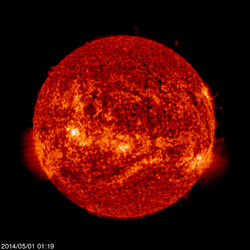 May 1, 2014 John E. Ross, KD8IDJ, Editor
| |||||||||
Public Service: SKYWARN, ARES Volunteers Muster for Severe Weather Onslaught Amateur Radio Emergency Service (ARES) and SKYWARN teams activated in late April as severe weather, including devastating tornadoes, struck mainly in the Deep South and Midwest. As rain continued into the week, the National Weather Service (NWS) said flash flooding was possible from southern New England to the Gulf Coast. On April 28, tornadoes raked Mississippi, Alabama, Arkansas, Missouri and other states. Upward of three dozen people died. According to Mississippi Gov Phil Bryant, tornadoes inflicted "severe damage" in
and around Louisville, some 100 miles northeast of Jackson. Tupelo also was hit; television viewers in that city watched as WTVA's chief meteorologist exited the set after ordering his colleagues to take cover. "Preliminary reports indicate extensive damage in the Jackson Metro, Winston County, and Lee County," ARRL Mississippi Section Manager Malcolm Keown, W5XX, said April 29. "ARES/SKYWARN activated over the state providing ground-truth weather and damage reports to NWS-Jackson and NWS-Memphis. One 400 foot ham tower was lost in Northeast Mississippi which supported multiple repeaters." More than a dozen died in weekend Arkansas storms; other fatalities were reported in Tennessee, Oklahoma, and Iowa. Forecasters say the spate of severe weather could continue through the end of the week. Arkansas Section Central District Emergency Coordinator and Arkansas SKYWARN volunteer Danny Straessle, KE5WLR, told ARRL that the NWS Little Rock Forecast Office contacted him on Saturday morning.
"We immediately received a report from Harold Higgins, W5HWH, in west Pulaski County of 80 MPH winds, trees down, and power out," Straessle said. Then, Tim King, KC5GNJ, reported debris and rotation -- the first actual tornado sighting. The twister proceeded into Mayflower and crossed Interstate Route 40, which was subsequently shut down. "As the storm crossed the Arkansas River," Straessle said, "Adam Flynn, W5FJC, was the first to report that a second vortex had appeared." A tornado emergency was issued for Mayflower and Vilonia. "I can see a very, very wide tornado on the ground to the west," Flynn told the net. Behind the storm, Flynn followed up with reports of downed power lines and a damage path. Widespread property damage was reported in Mayflower and Vilonia, north of Little Rock. Tim Hunter, N5RZX, told the net from downtown Vilonia that he had eyes on the storm, which affected him personally. Other SKYWARN volunteers reported a second funnel trailing the first, and subsequent eyewitness reports confirmed the tornado. The net finally shut down at 4:45 Monday morning. Straessle said he was pleased that Arkansas SKYWARN Amateur Radio storm spotters were able to provide "a virtual play-by-play" as the storms passed through. "While the forecasters had their eyes glued to the radar, their ears were glued to reports coming in from Arkansas SKYWARN," he said. Straessle added that the net "went like clockwork."
Lafayette County, Missouri, ARES EC Jack Green, KD0CYM, said ARES was called out on Sunday April 27. "Around 1 PM we received word of a sighting south of Bates City, [and] we deployed. Around Higginsville, we had very strong winds that blew very large signs down, tore shingles off houses, and broke off large tree limbs," he told ARRL. Green said the 13 deployed spotters then stood down to regroup for the next front, but the tornado activity stayed to the south. Ray County, Missouri, northwest of Kansas City, also experienced some severe weather over the weekend. ARES EC Randal Kennett, W0RAK, reported that Amateur Radio volunteers started up a net on the Richmond repeater and exchanged condition reports. A funnel cloud appeared some 4 miles from Kennett's home. "Tornado warnings were broadcast by NWS for most of the towns in my area," he said, but a downed tree in Hardin was the worst damage he observed. Much of the US South and Southeast experienced heavy rainfall as a result of the persistent storm systems, and flood warnings were posted in several states. Some regions received more than a foot of rain in 24 hours. The Florida Panhandle was especially hard hit by flooding. Public Service: Washington Landslide ARES/RACES Activation Ends ARRL Western Washington Section Manager Monte Simpson, K2MLS, has reported that Amateur Radio's role in the search phase of the Snohomish County Auxiliary Communications Service (Snohomish ACS -- formerly RACES) Radio Officer Scott Honaker, N7SS, said operations in Oso have been turned over to the state to get State Highway 530 re-opened. He said the search will continue at a lower level for the last two missing people. From the time the landslide occurred on March 22, Amateur Radio volunteers staffed some 160 shifts in the emergency operations center and command vehicle, Honaker said. "The early ones were 12-hour shifts, including the dreaded 7 PM to 7 AM shift," he noted. "I can't thank everyone enough for their support during this operation!" "[E]veryone agrees communications went extremely well," he said. "We were able to get everything we needed into the field, and the
infrastructure performed perfectly. We actually had additional VHF infrastructure and resources that were never used." Honaker pointed out that the County EOC in Everett and the command vehicle in Darrington had limited access to information to maintain situational awareness, but ham radio operators were able to bridge the gap to those in the field. "You were that safety net," he said, "and a number of reports were passed along that were quite valuable about search discoveries, injuries, additional slide activity, river and channel conditions, 'misplaced' aircraft, etc." Honaker said he heard "many positive comments" about how the radio room "just worked, unlike other parts of the operation that required more attention." He said others have commented about how well Amateur Radio volunteers and professional staffers worked together, both in the field and behind the scenes. "We had some concerns about how we'd integrate other teams into our operations but it worked unbelievably well," he said. ARRL Centennial: Convention Forums to Feature Presentation by Nobel Laureate Joe Taylor, K1JT Nobel Laureate Joe Taylor, K1JT, will be the featured speaker for a large-group presentation at the ARRL Centennial Convention, July 17-19, in Hartford, Connecticut. Taylor's Saturday, July 19, noon presentation, "Gazing into the Future -- DXing with Weak Signals and Beyond," will take place in the large meeting hall at the Connecticut Convention Center.
"We are pleased that a technological innovator of Joe Taylor's stature has agreed to be part of our program schedule," ARRL Centennial Convention Program and Forum Chairman Dan Henderson, N1ND, said. "His work in weak-signal detection has helped revolutionize many aspects of Amateur Radio, and his forum is a 'can't miss' opportunity for Convention-goers." Other presenters on the Convention's Friday and Saturday Forum schedule include former FCC Special Counsel Riley Hollingsworth, K4ZDH. His presentation is entitled, "Turning the 'Big Dial' -- It's More than Simply Changing the Frequency." Propagation expert Carl Luetzelschwab, K9LA, will give two presentations -- "160 Meters -- Mastering the Challenge" and "Propagation Forecasting -- a Peek Behind the Curtain." ARRL antenna guru Dean Straw, N6BV, will discuss, "How to Blow Up Your Balun -- and Other Things in Your Antenna System Too!" Additional details have been added to the day-long "Training Tracks" on Thursday. Sessions will include "Leadership and Training Tools for Amateur Radio," "Public Service Communications Academy," "RFI-101," "An Introduction to Amateur Satellites," "DX University," "Contest University," and "Amateur Radio Legal Seminar."
Henderson said the Convention has added 6 hours of "Youth in Amateur Radio" forums and programs to the Convention schedule. Three hours will be offered on both Friday and Saturday. FEMA Administrator Craig Fugate, KK4INZ, will deliver the Friday banquet address. W1AW Centennial Operations Shift States on May 7 (UTC) The ARRL Centennial W1AW WAS operations taking place throughout 2014 from each of the 50 states now are in Connecticut (W1AW/1) and Nevada (W1AW/7). The W1AW portable operations will relocate at 0000 UTC on Wednesday, May 7 (the evening of May 6 in US time zones), to Nebraska (W1AW/0). There will be no "second" state that week. The Utah (W1AW/7) operation initially scheduled now will take place starting July 2 (UTC). This will be the second and final opportunity to work W1AW from Nebraska for the ARRL Centennial QSO Party and for the "Worked All States W1AW Award." During 2014 W1AW will be on the air from every state (at least twice) and most US territories, and it will be easy to work all states solely by contacting W1AW portable operations.
Working W1AW/x from each state is worth 5 points per contact, even when working the same state during its second week of activity. To earn the "Worked all States with W1AW Award," work W1AW operating portable from all 50 states. (Working W1AW or W100AW in Connecticut does not count for Connecticut, however. For award credit, participants must work W1AW/1 in Connecticut.) A W1AW WAS certificate and plaque will be available. The ARRL has posted an ARRL Centennial QSO Party leader board that participants can use to determine how many points they have accumulated in the Centennial QSO Party and in the W1AW WAS operations. Log in using your Logbook of The World (LoTW) user name and password, and your position will appear at the top of the leader boards. Results are updated daily, based on contacts entered into LoTW. Science: Amateur Radio Propagation Guru Says Extended Solar Ebb May Lie Ahead Amateur Radio propagation and solar phenomena authority Carl Luetzelschwab, K9LA, said in an April 27 webinar, "Are We Headed into Another Maunder Minimum? What Does That Mean for Propagation?" that most solar scientists believe several low solar
cycles lie ahead, ushering in periods of diminished HF propagation, especially on the higher bands. Luetzelschwab, who maintains K9LA's Amateur Radio Propagation Web Site and pens a regular "Propagation" column for NCJ, stopped short of concluding that we'll experience a Maunder minimum -- an extended period of very few or no sunspots. As the Marshall Space Flight Center's "Solar Physics" web page explains, early sunspot records indicate that the Sun went through an inactive period from about 1645 to 1715 -- called the Maunder minimum after the scientist who discovered it -- when very few sunspots were observed. "Right now there's nothing bulletproof to say we're heading into a Maunder minimum, so we're just going to have to wait and see," Luetzelschwab told the webinar, sponsored by the World Wide Radio Operators Foundation (WWROF). "It sure looks like something inside the sun changed around the peak of Cycle 23. There's lots of evidence that we're entering a grand solar minimum. But I don't think any of the solar scientists are 100 percent sure that we're going to see a Maunder-type minimum." A grand solar minimum, he explained, is an extended period of low sunspot activity that is not as severe as a Maunder minimum. Many solar scientists believe that Cycle 24 -- the current solar cycle -- is the weakest in years, and that this portends even less sunspot activity in the future. Some even have predicted outright that a Maunder minimum is around the corner. In the hour-long presentation, Luetzelschwab reviewed the conclusions of research published by several solar scientists, raising various scenarios for what might lie ahead in terms of sunspots and related HF propagation. If a Maunder minimum were to occur, he predicted "we'll probably have some pretty good low-band propagation. Most everybody believes the low bands are better at solar minimum." But he conceded that a lot of factors come into play when trying to foresee what will happen from one solar cycle to the next and how it will affect radio propagation. "We need to gather some really good data" over the next 10 years, Luetzelschwab concluded, adding that the additional data will provide evidence one way or the other. "Are We Headed into Another Maunder Minimum? What Does That Mean for Propagation?" will be posted in the webinar archive on the WWROF website. Read more. Regulatory: AM Broadcasters, Hams Have Common Interest in Cleaning Up Noise Sources Radio amateurs and AM broadcasters have some common ground in wanting to clean up "a worsening RF noise environment in the AM broadcast band," according to recent comments filed with the FCC by the Society of Broadcast Engineers (SBE) on the issue of revitalizing AM broadcasting. ARRL General Counsel Chris Imlay, W3KD, who is also general counsel for the SBE, drafted the remarks.
While that approach has succeeded in some cases, Imlay wrote, "more often, utilities do not have available to them -- and are not willing to retain -- persons skilled in RF interference resolution, and the cases at FCC are allowed to languish unresolved for years...without any enforcement action at all." The SBE noted that AM listeners often are in vehicles adjacent to power lines that "frequently radiate RF noise" at levels to make AM reception difficult or impossible. The SBE comments also pointed to "substantial numbers of complaints of harmful interference to Amateur Radio stations" from LED lighting systems, noting that many RF light bulbs could be within range of a typical AM broadcast receiver in the typical residential neighborhood. Imlay used recent ARRL Laboratory RF lighting test results as one example to illustrate the problem.
"[T]he goal of AM revitalization will never be realized in the medium and long term in the face of the headwind of a worsening RF noise environment in the AM broadcast band," the SBE said, noting that the same concerns apply to all bands between 9 kHz and 30 MHz. "Some regulatory relief is absolutely necessary," the SBE concluded. The situation may already be improving. Last month the FCC cited a Washington resident for operating an "incidental radiator" -- apparently some sort of lighting device -- that has been causing harmful interference on Amateur Radio frequencies. The Commission has ordered the individual to stop using the device. Read more. Awards: ARRL Hudson Division 2013 Awards Banquet Benefits Spectrum Defense Fund Proceeds from the 2013 ARRL Hudson Division Awards Banquet last fall have been donated to the ARRL Spectrum Defense Fund by banquet sponsor, the Orange County Amateur Radio Club (OCARC) The donation totaled nearly $5000, a record for the Division. Nearly 170 attended. Awards for 2012 and 2013 were presented, since the 2012 banquet had to be called off due to Hurricane Sandy.
Award recipients were Amateur of the Year: Richie Cetron, K2KNB, (2012) and Kevin Morgan, AB2ZI (2013); Special Achievement: Len Signoretti, N2LEN, (2012) and David Galletly, KM2O (2013); Grand Ol' Ham: Sid Wolin, K2LJH, (2012) and Tony Pazzola, W2BEJ (2013). "Sadly, the news came only a week following the banquet, that Sid Wolin was a Silent Key," Shacklett said. "Seeing Sid accept the Grand Ol' Ham award made this banquet especially memorable." OCARC representatives presented a check for $4800 to the Spectrum Defense Fund at ARRL Headquarters in February. -- Thanks to Gordon Shacklett, KB2SSZ On the Air: Armed Forces Day 2014 Cross-Band Communications Test Set for May 10 The 2014 Armed Forces Day Cross-Band Communications Test will take place on Saturday, May 10. The US Army, Air Force, Navy, Marine Corps, and Coast Guard co-sponsor the annual Amateur Radio/US military communication test. The 64th Armed Forces Day officially takes place on May 17, but the Armed Forces Day radio event will take place a week earlier, on May 10, to avoid conflicting with Dayton Hamvention®. The on-the-air celebration features traditional military-to-Amateur Radio cross-band communication on both SSB and CW. Some activity will continue into the early hours of Sunday, May 11 (UTC). Most activity gets underway at 1200 UTC.
More than 20 military stations representing all of the services and in various parts of the Continental US, as well Hawaii (ABH), Okinawa (ADB) and Guam (NRV) are expected to be on the air, transmitting on military frequencies outside the Amateur Radio bands and listening for calls within Amateur Radio bands. Some military stations may not be on the air for the entire event, depending on propagation and station staffing. Participating military stations will transmit on selected Military Auxiliary Radio Service (MARS) frequencies and listen for Amateur Radio stations in certain bands and frequencies, depending on the station. The military stations have asked that radio amateurs limit voice contacts to no longer than a couple of minutes. Some military stations will use CW. Much of the activity will involve frequencies outside the 80, 40, and 20 meter bands. Participating US Army Stations will include WAR at the Pentagon, as well as AAZ, AAC, ABH, ADB, and WUG-23; US Air Force stations AIR, AGA2SY, AGA4AR, AGA5SC, and ARA9TR, and US Navy-Marine Corps stations NBL, NMC1, NMN, NNN0ASF, NNN0CQQ, NPD, NRV, NUW, NWKJ, and NWVC. The annual event also includes the US Secretary of Defense message test, which will be transmitted in various digital modes. Stations will use RTTY, CW, PSK31, PACTOR, AMTOR (FEC), MT63, and other digital modes to transmit the message. A certificate is available for stations correctly copying the message. Read more. ARRL Headquarters: ARRL E-Mail, LoTW, Online Store Will Be Down Overnight May 2-3! Network service at ARRL Headquarters will be down overnight, Friday, May 2/Saturday, May 3, from midnight until 8 AM EDT (0400 to 1200 UTC on Saturday, May 3) to facilitate the upgrade of the ARRL computer network. During that time all ARRL Headquarters services will be down, including Logbook of The World and the ARRL Store. E-mail sent to @arrl.org addresses will be queued for delivery when the network services are restored. Access to the ARRL website will not be affected during this shutdown. We appreciate your patience as we work on upgrading our computer infrastructure. Milestones: DXer, Author Wayne C. Long, K9YNF, SK Wayne C. Long, K9YNF, of Cascade, Wisconsin, died April 24. He was 67. A ham since 1960, Long enjoyed DXing and was on the DXCC
Honor Roll with 336 entities confirmed. He also was on the Islands on the Air (IOTA) Honor Roll, with 712 confirmed. A graduate of Northern Illinois University, he worked in the environmental services field for 25 years before retiring. Long spent his retirement writing short fiction and was a member of the Wisconsin Writer's Association. A review of his e-book, DX A Gift Like No Other, appeared in the February 2014 issue of QST. Survivors include his wife, Diane. A memorial service was held April 30. -- Thanks to The Daily DX Feature: A Century of Amateur Radio and the ARRL At the end of World War II, US soldiers and sailors were deployed all over the world, as were the troops of other nations. Among them were radio amateurs, itching to get back on the air. At their military radio stations, they could hear hams from countries around the world, as those governments allowed them back on the air again. But US servicemen and servicewomen in other countries faced a problem. To get on the legally was a bureaucratic nightmare that involved both US military officialdom and the government of the host country. Many hams solved the problem simply by going on the air.
In the late 1940s QST carried a number of articles written by those overseas hams. In many cases, the hams were enlisted men, and they might have to go through one or two or three echelons of command to get military permission to operate. But once they got that permission, they usually had high-power transmitters and good antennas, and they made themselves heard in the US and around the world. Yes, ham radio came back with a bang! Meanwhile, back in the US, as the HF ham bands were reopened, hams began getting back on the air. The old faithful brands of ham equipment reappeared in catalogs and stores -- now much improved and with better operating characteristics and circuitry, including built-in VFOs, something not common in the 1930s. In addition to the well-known manufacturers shifting their production lines from military equipment back to ham gear, a large number of smaller, new companies were formed to build ham equipment. These new companies mostly built transmitters, which could be put into production quickly and built at low cost, using military surplus parts. In many cases, hams could buy equipment that had been assembled and tested, or -- for considerably less money -- buy a kit of parts and put the gear together themselves. This started the trend for a growing percentage of hams to buy commercial HF transmitters, in kit form or ready-made, rather than building them from scratch, as most hams did in the 1930s. Many hams bought military surplus transmitters, either to cannibalize for parts or to modify for ham band use. Many military surplus HF receivers could be used with few or no modifications. As a result of new technology, as well as the availability of inexpensive military surplus equipment, the 1940s and 1950s became high-rolling times for amateurs. It was possible for hams licensed before the war as and newly licensed hams to get on the air with pretty good equipment at low cost. Then, in the 1950s, new FCC rules gave Amateur Radio a shot in the arm by bringing thousands of ham wannabes to the FCC examination table and then on the air. We'll look at that next week. -- Al Brogdon, W1AB In Brief...
FCC Enforcement Bureau Showing More Bite than Bark: The FCC has proposed fining a Florida man, Jason R. Humphreys, $48,000 for using a cell phone jammer in his car during his daily commute. Humphreys claimed he did so to keep other motorists from using their cell phones while driving. Humphreys' illegal jammer operation apparently continued for up to 2 years, causing interference to cellular service along a swath of Interstate 4, and also disrupting police and other emergency communications, the FCC said this week, in a Notice of Apparent Liability.
W1RO Appointed Nevada Navy-Marine Corps MARS Director: Jim Bassett, W1RO, of Las Vegas, Nevada, has been appointed Nevada State Director for Navy-Marine Corps Military Auxiliary Radio System (MARS). An ARRL Life Member, Bassett served more than 20 years in the US Navy and has more than 40 years' experience in communications and leadership. He's been a Navy-Marine Corps MARS member since 1970 and is a Clark County ARES/RACES volunteer.
The K7RA Solar Update Tad Cook, K7RA, Seattle, reports: Solar and geomagnetic activity slackened over the past week, with average daily sunspot numbers declining from 202.7 to 73.4, and average daily solar flux dropping from 160.4 to 122.6. The latest outlook has solar flux at 120 on May 1, 115 on May 2-4, 120 on May 5-8, 150 on May 9-13, 145 on May 14, 140 on May 15-17, and 135 on May 18.
Predicted planetary A index is 5 on May 1-2, 8 on May 3-4, 5 on May 5-13, 10 and 8 on May 14-15, and 5 on May 16-20. On April 27, OK1MGW of the Czech Propagation Interest Group predicted quiet geomagnetic conditions May 1-2, mostly quiet May 3, quiet to unsettled May 4, quiet May 5, quiet to unsettled May 6, quiet May 7, quiet to active May 8-9, quiet to unsettled May 10-11, mostly quiet May 12-13, quiet to unsettled May 14-15, quiet to active May 16-17, mostly quiet May 18-19, quiet to unsettled May 20-22, and mostly quiet May 23. This weekly "Solar Update" in The ARRL Letter is a preview of the "Propagation Bulletin" issued each Friday. The latest bulletin and an archive of past propagation bulletins is on the ARRL website. In tomorrow's bulletin look for an updated forecast and reports from readers, as well as updated sunspot averages through the end of April. Send me your reports and observations. Just Ahead in Radiosport
Visit the Contest Calendar for details. Upcoming ARRL Section, State and Division Conventions and Events
Find conventions and hamfests in your area.
ARRL -- Your One-Stop Resource for
Subscribe to...
Free of charge to ARRL members...
| |||||||||
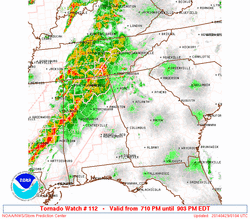
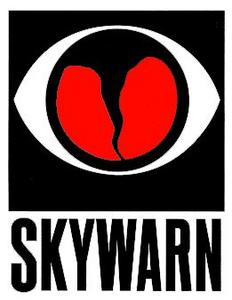 "Arkansas SKYWARN operates in the operations center at the Little Rock Forecast Office," Straessle explained. "This provides a direct benefit to the forecasters to have a direct ear-to-the-ground truth our operators provide." While much of Sunday was quiet, the NWS issued a tornado warning just after 7 PM, warning residents to take cover.
"Arkansas SKYWARN operates in the operations center at the Little Rock Forecast Office," Straessle explained. "This provides a direct benefit to the forecasters to have a direct ear-to-the-ground truth our operators provide." While much of Sunday was quiet, the NWS issued a tornado warning just after 7 PM, warning residents to take cover.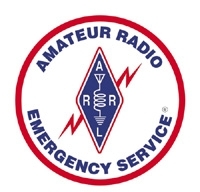 In Bates County, Missouri, on Sunday, William DelliPaoli, KD0PVP, reported that his SKYWARN net was able to get a warning out 20 minutes in advance to members in the fire department and city emergency operations center, where volunteers were monitoring. "I had been monitoring NWS chat all day and was prepared for the tornadoes entering Bates County," he told Mike Bellinger, K0UAA, Missouri District A Emergency Coordinator.
In Bates County, Missouri, on Sunday, William DelliPaoli, KD0PVP, reported that his SKYWARN net was able to get a warning out 20 minutes in advance to members in the fire department and city emergency operations center, where volunteers were monitoring. "I had been monitoring NWS chat all day and was prepared for the tornadoes entering Bates County," he told Mike Bellinger, K0UAA, Missouri District A Emergency Coordinator.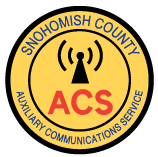 Snohomish County landslide has ended. "Our volunteers performed admirably and stepped up to the plate when they were needed the most," Simpson said. "Western Washington's Region/District 1 displayed the very highest in teamwork effort. I can't be more proud of this region/district."
Snohomish County landslide has ended. "Our volunteers performed admirably and stepped up to the plate when they were needed the most," Simpson said. "Western Washington's Region/District 1 displayed the very highest in teamwork effort. I can't be more proud of this region/district."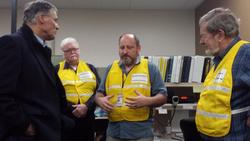
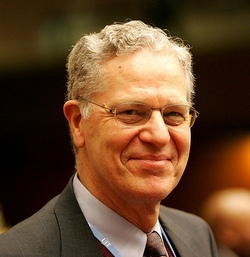
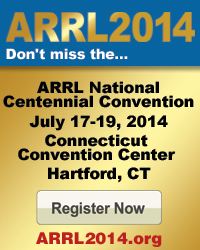
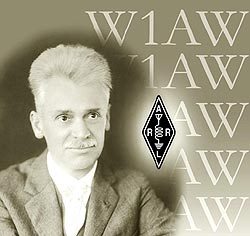 In conjunction with the 100th anniversary of the ARRL, the
In conjunction with the 100th anniversary of the ARRL, the 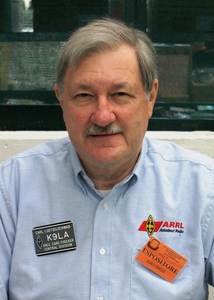
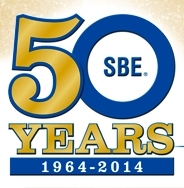 "There are numerous complaints from Amateur Radio operators of severe interference from power line noise annually," said the SBE comments, filed earlier this year. "Power line radiation in the HF and MF Amateur allocations will in most cases directly translate to preclusive noise in the AM broadcast band. The Commission has relied completely on the good faith efforts of electric utilities to resolve these."
"There are numerous complaints from Amateur Radio operators of severe interference from power line noise annually," said the SBE comments, filed earlier this year. "Power line radiation in the HF and MF Amateur allocations will in most cases directly translate to preclusive noise in the AM broadcast band. The Commission has relied completely on the good faith efforts of electric utilities to resolve these."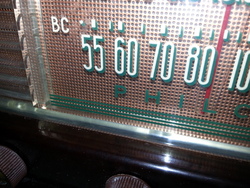 The SBE comments cited an RF lighting ballast used for indoor gardening that generated excessive conducted emissions that could "preclude AM broadcast reception over entire residential subdivisions." The ARRL formally
The SBE comments cited an RF lighting ballast used for indoor gardening that generated excessive conducted emissions that could "preclude AM broadcast reception over entire residential subdivisions." The ARRL formally 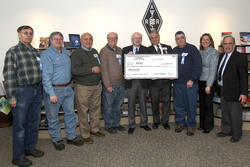
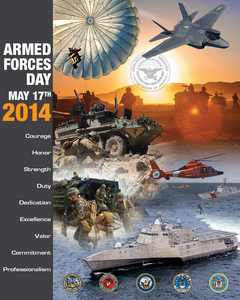 "These tests give Amateur Radio operators and Short Wave Listeners (SWLs) an opportunity to demonstrate their individual technical skills, and to receive recognition from the appropriate military radio station for their proven expertise," the Armed Forces Day Cross-Band Communication Test announcement said. "QSL cards will be provided to those stations making contact with the military stations."
"These tests give Amateur Radio operators and Short Wave Listeners (SWLs) an opportunity to demonstrate their individual technical skills, and to receive recognition from the appropriate military radio station for their proven expertise," the Armed Forces Day Cross-Band Communication Test announcement said. "QSL cards will be provided to those stations making contact with the military stations.".jpg)
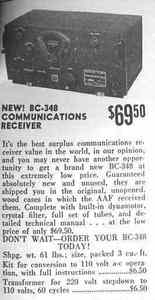
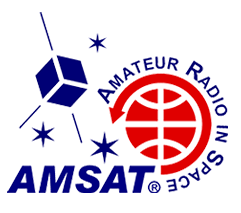 AMSAT-NA Has Moved! After 30 years in the same location,
AMSAT-NA Has Moved! After 30 years in the same location, 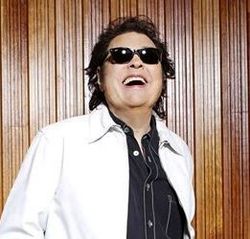 Country Music Singer Ronnie Milsap, WB4KCG, is CMA Hall of Fame Inductee: Country music's Ronnie Milsap, WB4KCG, has been tapped for induction into the Country Music Hall of Fame. The winner of six Grammy awards, Milsap had 40 No. 1 hits and sold more than 35 million albums during the heyday of his career in the 1970s and 1980s. The 71-year-old pianist and North Carolina native started out as a rhythm and blues performer and once served as a session musician for Elvis Presley.
Country Music Singer Ronnie Milsap, WB4KCG, is CMA Hall of Fame Inductee: Country music's Ronnie Milsap, WB4KCG, has been tapped for induction into the Country Music Hall of Fame. The winner of six Grammy awards, Milsap had 40 No. 1 hits and sold more than 35 million albums during the heyday of his career in the 1970s and 1980s. The 71-year-old pianist and North Carolina native started out as a rhythm and blues performer and once served as a session musician for Elvis Presley.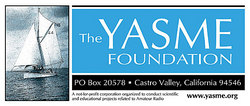 The Yasme Foundation Elects Directors, Officers: At the 2014 International DX Convention,
The Yasme Foundation Elects Directors, Officers: At the 2014 International DX Convention, 